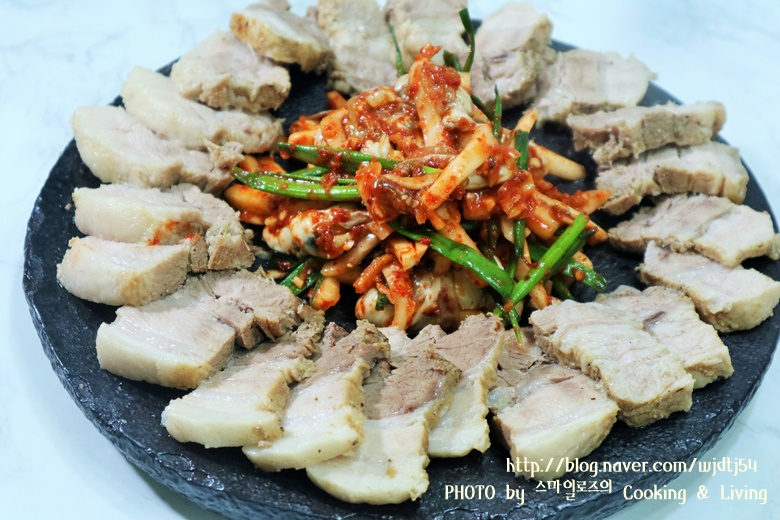Tender and Juicy Boiled Pork Belly (Suyuk)
How to Boil Pork Belly for Bossam: A Delightful Meal with Neighbors During Kimchi Season

Bossam Suyuk is an indispensable dish during the Kimchi-making season! Although I made a large batch of Kimchi this year, I was fortunate to get some excellent pork belly from Meatbox, which allowed me to boil a generous amount and share a wonderful time with my neighbors. Served with homemade Bossam Radish Kimchi, everyone praised the suyuk for its delicious flavor and lack of gamey smell. We boiled so much that it had to be refilled onto the serving plate twice!
Ingredients- Pork Belly 2.5kg
- Doenjang (Soybean Paste) 2 Tbsp
- Whole Garlic Cloves 10
- Instant Coffee (Espresso Powder) 1 Tbsp
- Ginger 1 knob (thumb-sized)
- Scallions 2
- Onion 1
- Scallion Roots 5
- Bay Leaves 3-4
- Whole Peppercorns 1/2 Tbsp
Cooking Instructions
Step 1
I decided to boil one piece of the 2.5kg pork belly first, as it’s a large amount. The fresh, appetizing color of the meat makes it look delicious just by looking at it. First, place the pork belly in enough cold water to cover it completely and let it soak to remove any blood. About 30 minutes should be sufficient.

Step 2
For the aromatics to boil with the pork, you can use whatever ingredients you have on hand. You don’t need special items to make delicious suyuk.

Step 3
After soaking the pork to remove blood, place it in a pressure cooker and add enough water to cover the meat. Using a pressure cooker significantly reduces cooking time and results in chewier, more flavorful pork.

Step 4
Pour water to cover the blood-removed pork, and add 2 Tbsp of Doenjang and 1 Tbsp of coffee. Doenjang helps eliminate any porky smell, and coffee enhances the color and adds depth of flavor.

Step 5
Add all the remaining ingredients. For convenience in removing them later, it’s helpful to place the 10 whole garlic cloves, 1/2 Tbsp of whole peppercorns, the washed scallion roots (about 5), and the knob of ginger into a mesh bag before adding them to the pot. Don’t forget to add the bay leaves as well.

Step 6
If you were to use a regular pot, it would take about 2 hours. However, a pressure cooker significantly cuts down the cooking time. Once the pressure cooker’s weight starts whistling (‘chik’), continue to cook for another 20 minutes. Turn off the heat and let it rest for about 10 minutes before opening the lid. You’ll find tender and delicious suyuk ready to enjoy.

Step 7
As I sliced the freshly boiled suyuk, it was brimming with juices, and its tenderness and richness were truly remarkable. The piece I tasted while slicing melted in my mouth, perfectly illustrating the saying ‘melts in your mouth’.

Step 8
Check out this link for a delicious Bossam Radish Kimchi recipe: https://blog.naver.com/wjdtj54/222148341420 (Despite the strong winds overnight, I prepared this meal to share with my neighbors. The Bossam Radish Kimchi has a wonderfully crisp texture.)

Step 9
I arranged the suyuk attractively on a platter and topped it with the prepared Bossam Radish Kimchi. For detailed instructions on how to make the Bossam Radish Kimchi, please refer to the link above.

Step 10
It’s best to let the suyuk cool slightly before slicing for a prettier presentation. However, since my neighbors were waiting, I sliced it while it was still hot, so the shapes are a bit less perfect. Still, the taste was absolutely fantastic!

Step 11
While serving with salted shrimp (saewoojeot) is delicious, with guests present, I opted for the homemade Bossam Radish Kimchi. Everyone thoroughly enjoyed it, which made me feel very pleased.

Step 12
Suyuk is a wonderful dish that can be enjoyed not just during Kimchi season but anytime. Serving it at a meal shared with family or cherished friends makes the occasion even more abundant and joyful.




